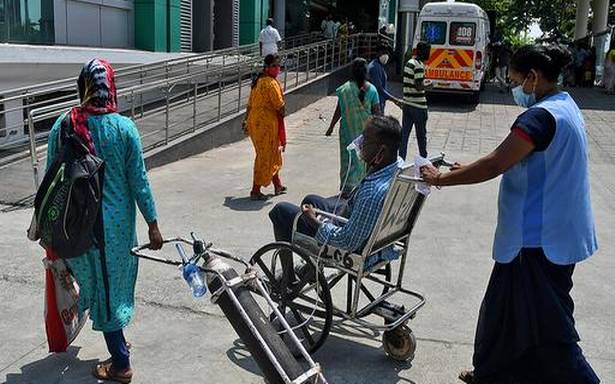Hospitals do audit, use devices for delivering appropriate amounts to patients
Facing high demand, many hospitals have chalked out strategies for the optimal use of oxygen. From doing their own oxygen audits to turning to devices for delivering appropriate amounts to patients, a number of hospitals are leaving no stone unturned to prevent wastage.
As COVID-19 cases continue to surge in Tamil Nadu, the demand has been soaring over the past several weeks. Not wanting to take any chance — considering the uncertainty over the supply of the now-scarce resource — hospitals have taken measures for judicious use of oxygen.
According to a section of government doctors, one of the biggest problems was patient attenders increasing the flow of oxygen by means of the flow meters attached to the central supply. “They change the flow from 10 to 15 litres or 20 to 30 litres. Owing to the high case load and less manpower, monitoring each and every aspect is difficult. This results in wastage,” a senior doctor said.

To ensure that the available resource was used appropriately, the Rajiv Gandhi Government General Hospital formed a respiratory care team, comprising a professor of anaesthesia, an assistant professor, a staff nurse, an anaesthesia technician and a post-graduate student in anaesthesia. “This team carries out daily analysis and monitors oxygen therapy for patients. At times, patient attenders increase the oxygen requirement level on their own. To conserve oxygen, this team audits the daily requirement of oxygen for each person. We want to cut down on excess use and put in place an appropriate therapy,” Dean E. Theranirajan said.
J.V. Peter, director of Christian Medical College, Vellore, said the hospital came up with a five-point strategy — avoiding the use of “oxygen guzzlers” such as high-flow nasal cannula; “oxygen stewardship programme” with nurses and therapists functioning as stewards and auditors of oxygen use; “more for less” — the use of devices such as non-invasive ventilators, non-rebreather mask or partial rebreather masks with reservoir bags to reduce oxygen use; “resetting safe oxygen targets” — 92% to 94%; and “reducing the pressure on liquid oxygen” with the use of oxygen concentrators. “We were able to reduce oxygen use by 10% to 12%. This strategy was to conserve oxygen and optimise its use… A rupee saved is a rupee earned. Similarly for oxygen, a litre saved is a litre produced,” he said.
Throughout the State, hospitals are trying to bring down the use of high-flow nasal cannula, a senior government doctor said. “Instead, we are using devices that give patients the correct amount of oxygen… These airway devices deliver metered doses of oxygen. Some hospitals use venturi masks, in which we can set the amount of oxygen required by a patient,” the doctor said.
Almost all hospitals are on their toes for 24 hours when it comes to audits. “We calculate the per hour oxygen usage and the number of patients on oxygen support. If it does not tally, we find out the reason,” the doctor said.
At the Government Corona Hospital, Director K. Narayanasamy said for patients with oxygen saturation of 80%, rescue therapy was done with high-flow oxygen for an hour. “Once the levels improve to 92%-93%, we move to low-flow oxygen. We continue to monitor and wean the patient off oxygen support,” he said.
Source: Read Full Article

